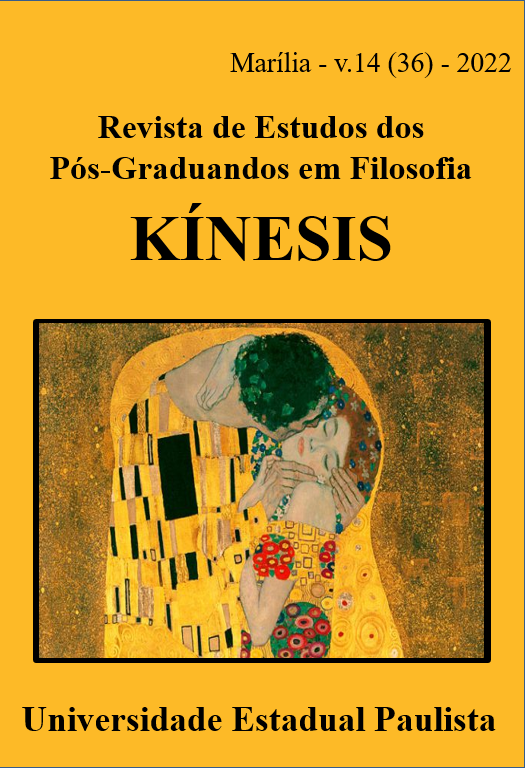“YOU AND I DO NOT ‘SHARE’ THE SAME CONSCIOUSNESS”: APPLYING A NOMINALIST BUDDHIST SEMANTIC PERSPECTIVE TO THE GENERAL EXPRESSION “CONSCIOUSNESS”
DOI:
https://doi.org/10.36311/1984-8900.2022.v14n36.p395-417Palavras-chave:
Buddhist philosophy, Exclusion/disregard (apoha) semantics, General expressions, Nominalist Buddhist semantics, Individual’s own consciousnessResumo
It is recognized that Buddhadharma schools are markedly ontologically, epistemologically, and semantically nominalist. Regardless of that, when it comes to the use of the term “consciousness”, there is still a tendency in some Western circles to understand Buddhism in a solipsist or monist way. To this purpose, I argue that the general expression “consciousness” from Buddhadharma texts must be understood according to traditional nominalist Buddhist semantics and theory of entities. In the end, I briefly mention some arguments and viewpoints – defending the plurality/diversity of consciousness – of some Buddhist Dzogchen scholars and masters.
Downloads
Referências
BHATT, S. R.; MEHROTRA, Anu (2000). Buddhist Epistemology. London: Greenwood Press.
CHAKRABARTI, A.; SIDERITS M. (2011). “Introduction” in Apoha: Buddhist Nominalism and Human Cognition, eds. Mark Siderits., Tom Tillemans, and Arindam Chakrabarti. New York: Columbia University Press: 1-49.
CHATTERJEE, A. (2011). “Funes and Categorization in an Abstract-Free World” in Apoha: Buddhist Nominalism and Human Cognition, eds. Mark Siderits., Tom Tillemans, and Arindam Chakrabarti. New York: Columbia University Press: 247-257.
DOUVEN, Igor. “Abduction,” The Stanford Encyclopedia of Philosophy, 2015 (summer 2017 edition), ed. Edward N. Zalta. Disponível em: https://plato.stanford.edu/archives/sum2017/entries/abduction/. Acesso em: 08 April
DRAVID, R. R. (2001). The problem of universals in Indian philosophy. 2nd ed. Delhi: M. Barnasidass, Delhi.
DREYFUS, Georges B. (1997). Recognizing Reality, Dharmakīrti’s Philosophy and its Tibetan Interpretations. Albany, NY: State University of New York Press.
GILLON, S. B. (2011). “Classical Semantics and Apoha Semantics” in Apoha: Buddhist Nominalism and Human Cognition, eds. Mark Siderits., Tom Tillemans, and Arindam Chakrabarti. New York: Columbia University Press: 273-282.
GOLD, C. J. (2014). “Sakya Pandita’s Anti-Realism as a Return to the Mainstream”. Philosophy East and West 64(2): 360-374.
HAYES, P. R. (1988). Dignaga on the Interpretation of Signs. Dordrecht: Kluwer.
JAMPAIYANG, Chim; COGHLAN, Ian (translator) (2019). Ornament of Abhidharma: A Commentary on Vasubandhu's Abhidharmakosa. Somerville, MA: Wisdom Publications.
JONES, R. (2011). Indian Madhyamaka Buddhist Philosophy After Nagarjuna, Volume 1: Plain English Translations and Summaries of the Essential Works of Aryadeva, Rahulabhadra, Buddhapalita, Bhavaviveka. New York: CreateSpace Independent Publishing Platform.
LONGCHEN Y. D.; LINGPA, Jigme (2010). Treasury of Precious Qualities, Book One: Sutra Teachings. Translated by the Padmakara Translation Group. United States of America: Shambhala Publications.
NAMDAK, T. L. (2006). Bonpo Dzogchen Teachings according to Lopon Tenzin Namdak. Nepal, Kathmandu: Vajra Publications.
NORBU, N. C. (1996). Dzogchen: The Self-Perfected State. New York: Snow Lion Publications.
RINPOCHE, J. M. (2004). Gateway to Knowledge: A Condensation of the Tripitaka, Vol. 1. Hong Kong: Rangjung Yeshe Publications.
RINPOCHE, U. T. (1992). Repeating the Words of the Buddha. Kathmandu: Rangjung Yeshe Publications.
ŚĀNTARAKṢITA; GANGANATHA Jha (translator) (1937). The Tattvasaṅgraha of Śāntarakṣita with the Commentary of Kamalaśīla. In Two Volumes. GOS, Gaekwad’s Oriental Series 80–83. Baroda: Oriental Institute.
SIDERITS, Mark (1991). Indian Philosophy of Language: Studies in Selected Issues. Dordrecht: Springer-Science+Business Media, B.V.
SIDERITS, Mark; TILLEMANS, Tom; CHAKRABARTI, Arindam (2011). Apoha: Buddhist Nominalism and Human Cognition, eds. Mark Siderits., Tom Tillemans, and Arindam Chakrabarti. New York: Columbia University Press.
STOLTZ, Jonathan (2006). “Sakya Pandita and the Status of Concepts”. Philosophy East and West 56(4): 567–582.
TILLEMANS, Tom J. F (2014). Scripture, Logic, Language: Essays on Dharmakirti and his Tibetan Successors. Somerville: Wisdom Publications.
TILLEMANS, Tom J. F. Dharmakīrti. In The Stanford Encyclopedia of Philosophy, 2021 (spring 2021 edition), ed. Edward N. Zalta. Disponível em: https://plato.stanford.edu/archives/spr2021/entries/dharmakiirti/. Acesso em: 08 April 2021.
WAYMAN, L (1999). A Millennium of Buddhist Logic. Delhi: Motilal Banarsidass.
Downloads
Publicado
Edição
Seção
Licença
Copyright (c) 2022 Kínesis - Revista de Estudos dos Pós-Graduandos em Filosofia

Este trabalho está licenciado sob uma licença Creative Commons Attribution-NonCommercial-ShareAlike 4.0 International License.





